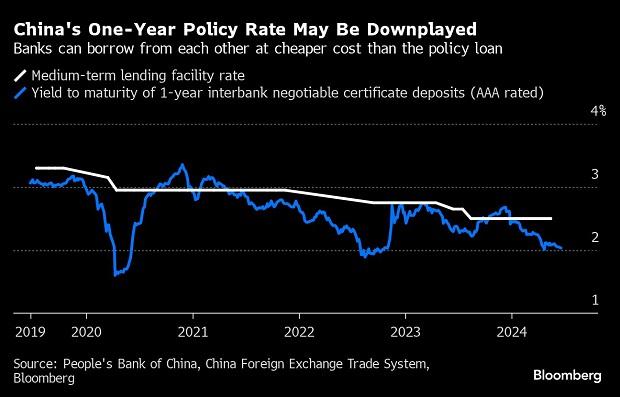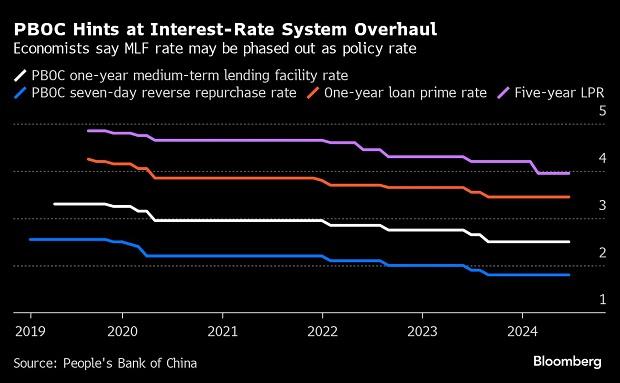Xi Jinping’s mysterious PBoC plans emerge in the biggest shift in years
It started with a cryptic quote from President Xi Jinping, buried in a 172-page book on the financial sector. Three months later, plans for possibly the biggest shift in years in the way China conducts monetary policy are beginning to surface.
Pan Gongsheng, governor of the People’s Bank of China, gave the clearest acknowledgment Wednesday that the monetary authority is exploring trading in government bonds on the secondary market as a way to regulate liquidity. The PBOC is studying the implementation together with the Ministry of Finance and it will be a gradual process, he said in a speech.
That’s in response to Xi’s directive to “enrich the monetary policy toolbox” and “gradually increase the buying and selling of government bonds in the central bank’s open market operation” in a speech at a financial policy meeting last year, which was only made public in the book published in March.
In addition, Pan alluded to other changes in the interest system. The bank could consider switching to using a single short-term rate to guide the markets. It is also considering narrowing the range within which market interest rates are allowed to fluctuate to indicate a clearer policy target.
To be fair, all of these steps are aimed at refining the technical tools the PBOC uses to manage interest rates and money. They won’t necessarily help answer some of the big questions currently facing Chinese policymakers – such as whether credit can support the economy if households and businesses are reluctant to take on more debt, or how to lower borrowing costs without weaken the economy. yuan. Many details remain vague, as does the timeline for change.
Some PBOC observers see the proposals as part of a decades-long shift in which the central bank has gradually given markets a greater role in setting interest rates.
The PBOC is also moving toward price-based instruments, such as interest rates, and downplaying quantity-based instruments, such as the amount of credit. Pan said Wednesday that it is time to pay less attention to loan growth, as lending by real estate developers and local governments is declining as part of the economy’s transition.
“Moving to a single short-term rate linked to the financial market as the main policy rate would be an obvious further step in the gradual reform of China’s monetary policy framework,” said Louis Kuijs, chief Asia-Pacific economist at S&P Global. Ratings. “It would make the framework simpler and more transparent, and bring it closer to the ‘industry standard’ used in most advanced economies.”
Others say the changes give the PBOC greater influence over both short-term rates and potentially longer-term rates.
Frederic Neumann, chief Asia economist at HSBC, said the PBOC’s bond trading is “an additional tool that allows them to essentially micro-manage the entire curve.” It would be akin to controlling the yield curve, he said, referring to the Bank of Japan’s policy of suppressing long-term borrowing costs to revive the economy. The Chinese emphasis on using credit efficiently rather than expanding it rapidly also points to a more central direction, according to Neumann.
One conclusion that many analysts drew from Pan’s speech is that the PBOC is preparing to downplay one of its most important tools: the one-year policy loans known as the medium-term loans. Since its introduction a decade ago, the MLF has become an important channel for the central bank to inject money into the economy and guide market interest rates.
But in recent months, banks’ demand for these funds has ebbed as it has become cheaper for them to borrow from each other. MLF rates have been held steady for 10 months even as other borrowing costs in the economy plummeted – partly because the PBOC is wary of a currency depreciation.

Moreover, the MLF is also only available to select banks. By buying and selling government bonds as an alternative way to manage liquidity, central bankers can influence the financial conditions of a wider range of market participants. And compared to the MLF, the interest rate on seven-day reverse repurchases – short-term loans available to banks on a daily basis – offers more flexibility in fine-tuning policy.
According to Serena Zhou, senior Chinese economist at Mizuho Securities Asia Ltd, Pan may think China’s interest rate market is now mature enough for the central bank to stop using multiple anchors to guide it.
Financial News, a PBOC-run newspaper, on Thursday quoted unnamed industry experts as saying that the central bank would examine the link between MLF – which represents banks’ funding costs – and the loan prime rate, a measure of interest rates. on loans to the real economy should weaken. economy. The latter is more important because borrowers’ actual costs are more important for economic growth, the report said.
Currently, LPRs are based on the interest rates that twenty banks offer their best customers. They are quoted as a spread over the MLF rate.

One likely goal is to provide a smoother transmission mechanism from short-term rates to longer-term rates.
The PBOC’s current design of using two policy rates – the seven-day reverse repo and the MLF – reduces the signaling effect of its monetary decisions, economists at Macquarie Group Ltd have argued. led by Larry Hu in a report Thursday.
Furthermore, the current interest rate corridor established by the PBOC – the range within which market interest rates should move – is too wide, they say, leading to a highly volatile market for seven-day interbank lending compared to much more stable interest rates. in the US and Europe.
First print: June 21, 2024 | 1:25 IST
